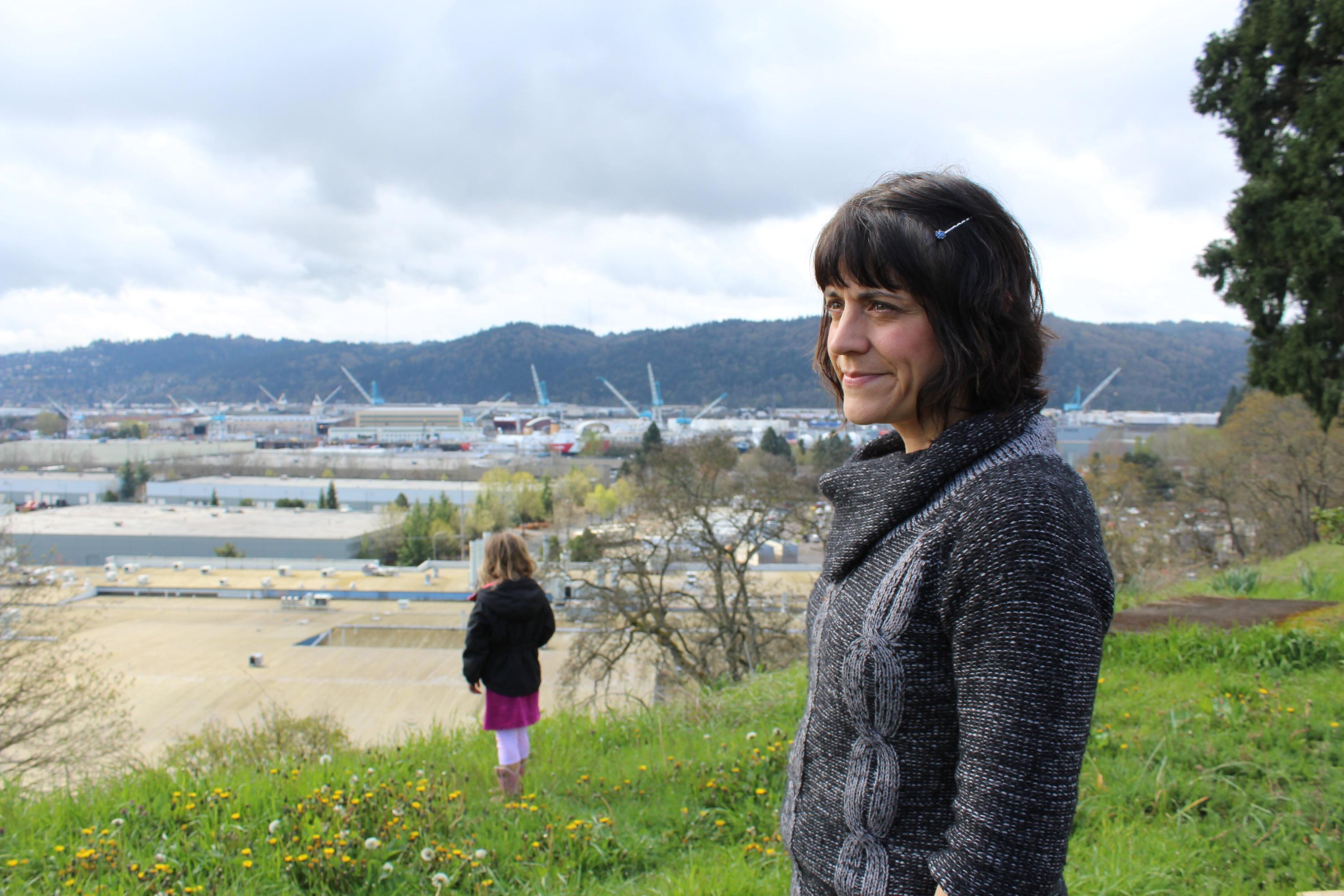
North Portland resident Stacey Schroeder stands on the bluff along WIllamette Boulevard overlooking Swan Island and the Daimler Trucks North America plant, as her daughter picks dandelions in the distance. Schroeder and other neighbors blame Daimler for paint odors in their neighborhood, and they blame the Oregon Department of Environmental Quality for failing to fix it.
Tony Schick / OPB/EarthFix
North Portland residents say state air testing in their neighborhood was flawed and doesn't address their longstanding concerns about strong paint odors.
Neighbors of the Swan Island industrial area voiced their complaints Monday night at a forum at the University of Portland.
Resident Laurie McLary told officials with the Oregon Department of Environmental Quality they put their air testing station in the wrong place.
"That is not Swan Island," she said. "That is outside the dome of doom, and it is not measuring the things that we are smelling in our neighborhood."
McLary said she's been complaining to DEQ about paint odors in her neighborhood since 1999.
"This has been going on for years and years and years and years, and there’s been no specific response," she told officials. "We can only come to the conclusion that DEQ is more concerned about protecting industry than the health of citizens in North Portland."
A year of air testing in the area found nine pollutants above the state’s health benchmarks, including acrolein, acrylonitrile, carbon tetrachloride and arsenic.
But officials say the results don’t explain the paint odors neighbors are complaining about. DEQ attributed most of the pollutants detected to emissions from cars, trucks and wood smoke.
University of Portland professor Ted Eckmann said the results are scientifically flawed and the agency's analysis is lacking. For example, he said, the DEQ failed to note that several of the pollutants detected through the state's testing can be used in painting operations.
Many of the pollutants detected above health benchmarks can cause cancer, he said, but the agency can't identify where they're coming from with the data collected.
"This is a blown opportunity," he said. "The same resources if they were organized differently from the beginning could have made a much clearer conclusion about the source."
Eckmann said even though the data is flawed, DEQ sill could have done a lot more analysis.
"There's definitely a lot in the air that's hurting people now," Eckmann said. "So the urgency should be there now to investigate it more thoroughly and do something about it quickly."
House Speaker Tina Kotek, D-Portland, who organized Monday's meeting and led a legislative effort to fund the air testing, said she's not satisfied with the results, either.
"It’s not the best data," she said. "I’m disappointed we don’t have more data and better data."
Oregon DEQ lab manager Brian Boling said so far the agency has only done a preliminary report that he called “a first look at the data set.” The agency collected 24-hour samples every six days, which he acknowledged isn't an effective method of monitoring a specific pollution source because it may not detect daily emission spikes.
Boling said DEQ is doing additional analysis that may help identify the sources of the pollutants detected, and he is comparing the results of a University of Portland odor study with the air testing data to see if he can identify what pollutants might be causing the paint odors.
"I don’t think we’re all happy with the methodology and analysis," Kotek told DEQ officials. "I would like to have that analysis happen sooner rather than later. We need to have that picture clarified quickly so we can solve the problem."
Many residents are convinced the smell is coming from the painting operation at the Daimler Trucks facility on Swan Island. But DEQ says the company is in compliance with its permits and has refused to enter a voluntary agreement to reduce its emissions.
Nina Deconcini, DEQ's Northwest region administrator, said the agency is in the process of rewriting air pollution rules statewide.
"The permitting program is the most effective way for us to target changes in what the company is doing," she said.
